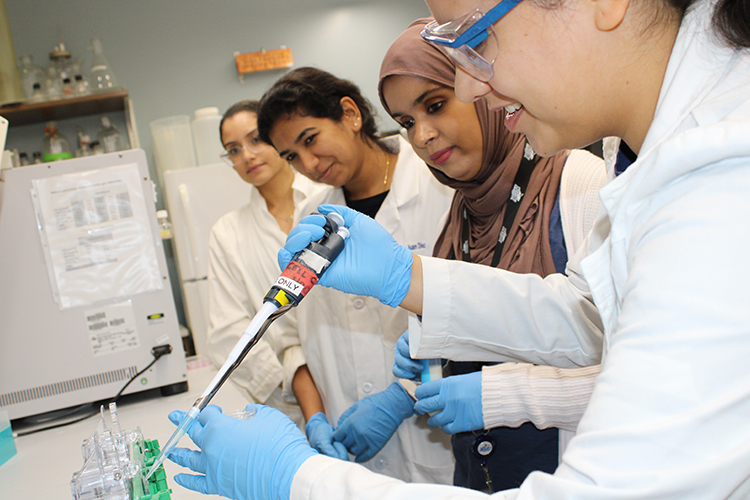NSU's Rumbaugh Goodwin Institute for Cancer Research, is conducting leading research on new cancer diagnostics and powerful therapeutics for breast, lung, prostate, ovarian and colorectal cancers. Rathinavelu et al have recently received U.S. patents for two an anti-angiogenic drugs that can destroys blood vessels supplying oxygen and nutrients through blood circulation to cancer tissues. Cancer treatment using these drugs code named F16 and JFD, will eventually shrink and destroy cancer tissues. Use pharmacogenomics and molecular modeling approaches were crucial in discovering these cancer drugs. The Rumbaugh Goodwin Institute for Cancer Research has already started pre-clinical trials with F16 and JFD to establish the safety and effectiveness of these drugs against breast cancer.
RGI's Human Breast Cancer Model / Strategies
We have a unique way to study breast cancer, using a model very similar to the disease in humans. GI-101 is a unique human mammary tumor xenograft line which metastasizes to the lungs of athymic nude mice at approximately day 45 post-transplant. To our knowledge, this is the only human mammary tumor xenograft which undergoes spontaneous metastases in an experimental host and is a unique opportunity to investigate the mechanism of metastases and test potential anti-metastatic therapies.
Our GI-101 Metastatic Breast Cancer Model is so novel that it was recently patented. Most scientists who study breast cancer can only study the “primary” tumor, that is the original lump in the breast. Unfortunately, people die not from this primary tumor but from the cancer that spreads out from this primary tumor. No one ever died from a lump in their breast. The cancer that spreads to the lungs, brain and bone marrow are what eventually kill the patient. Our GI-101 cell line gives scientists the ability to study the way cancer spreads and the best ways to stop it from spreading. This cell line mimics human cancer in a way that has never been done before, giving scientists a whole new way to develop anti-cancer drugs and treatments.
Self-examination, annual check-ups, and mammograms can detect breast cancer at an early stage, but many cases of breast cancer remain undiagnosed until it is too late. The earlier breast cancer is detected, the greater your chances of survival.
What occurs during the early stages of tumor growth that makes a relatively benign disease (a small lump in the breast) change into an invasive, deadly cancer? By understanding the actual cause of the spread of breast cancer, RGI can develop effective tests and treatments that will halt the progress of this deadly disease. We have already identified certain changes that breast cancer undergoes as it changes from a small, non-invasive lump to a deadly disease that spreads to your lungs and other organs. There is still much to be learned about why breast cancer spreads after it reaches a certain size. This information will aid in treating cancer patients.
Human breast cancers have proved to be among the most difficult tumors to grow in immunodeficient mice. Our human breast tumor xenograft line originated from a patient specimen which now consistently metastasizes to the lungs of athymic nude mouse hosts. The mammary tumor line (GI-101) was derived from a local first recurrence of an infiltrating ductal adenocarcinoma (Stage IIIa, T3N2MX) in a 57 year old female who had not received any therapy other than surgery. The tumor was implanted by trochar in 3-5 cubic mm pieces subcutaneously to the subaxial area of 12 week old athymic nude female mice.
Recipient animals are kept in a pathogen-free environment and are negative for pathogenic murine bacteria and viruses. Measurements of the xenografted subcutaneous tumors are performed using vernier calipers and the volume is calculated as a hemi-ellipsoid using the formula 0.5 (length x width x thickness). Tumor take rate is generally nearly 100%.
Metastases in the lung are detected by immunohistochemistry and molecular biology techniques. Metastatic lung foci can be detected around a volume of 300 cubic mm. The size and number of lung metastases are approximately proportional to tumor size. Both breast tumor and lung metastases show strong affinity for monoclonal antibodies to several breast tissue differentiation antigens.
Unlike breast tumor cell line implants, the breast tumor xenograft line requires a relatively long lag period before exponential growth is achieved and metastatic foci to the lungs become well-established.
Reference: 1993. J. Hurst, N. Maniar, J. Tombarkiewicz, F. Lucas, C. Roberson, Z. Steplewski, W. James, and J. Perras. A novel model of a metastatic human breast tumor xenograft line. Br. J. Cancer 68: 274-276.

